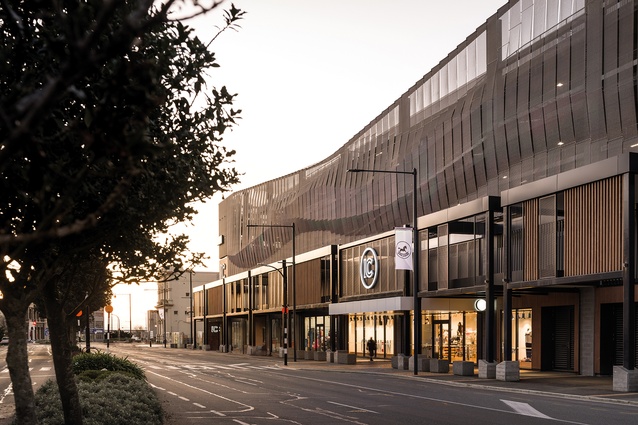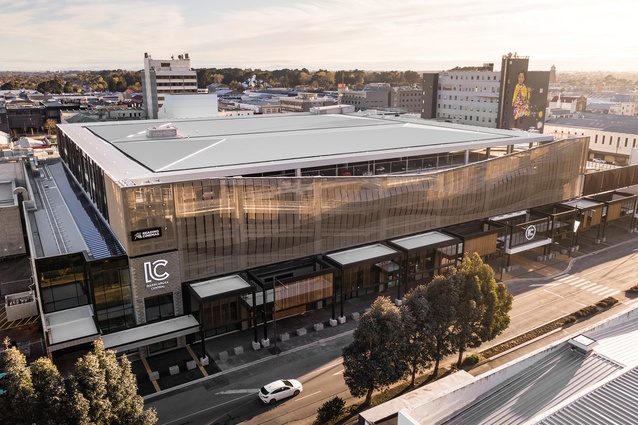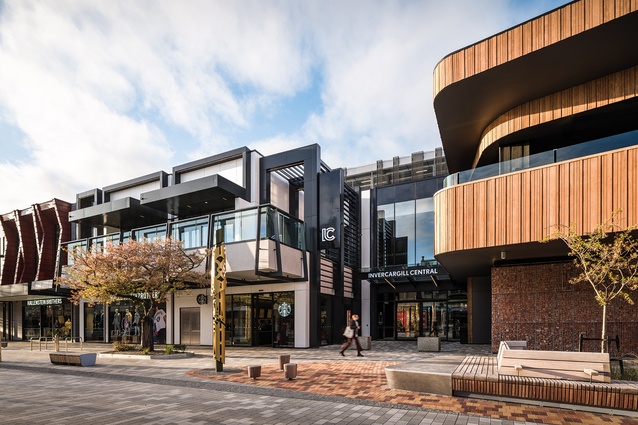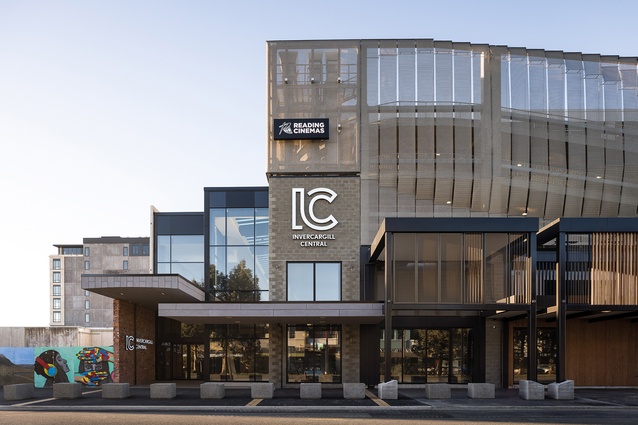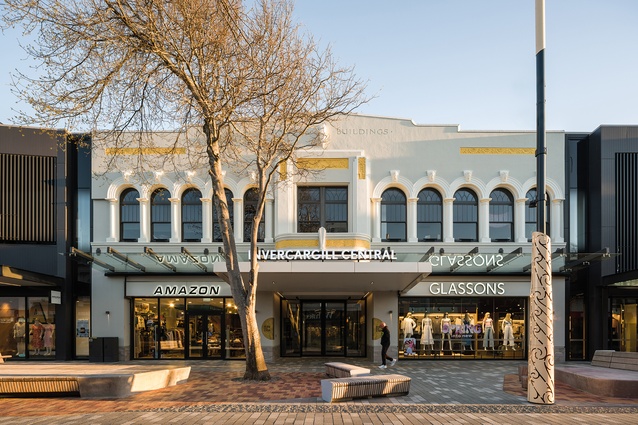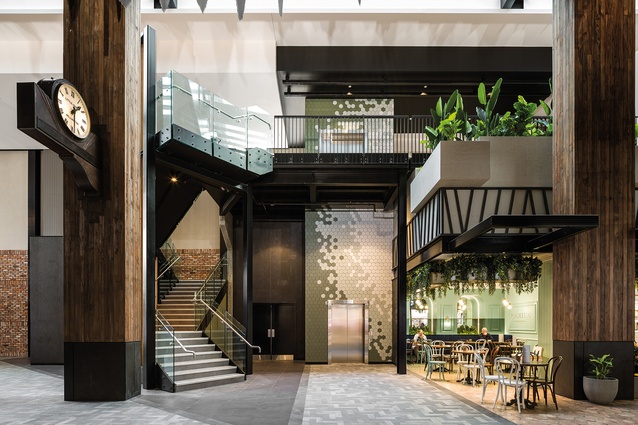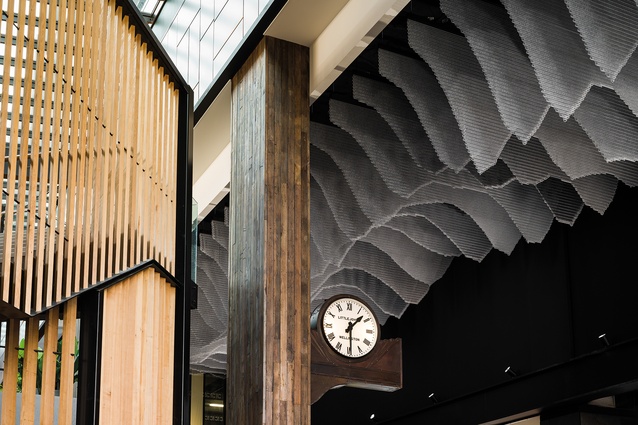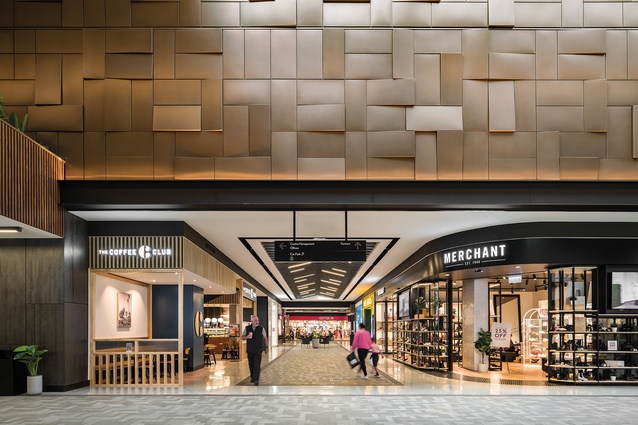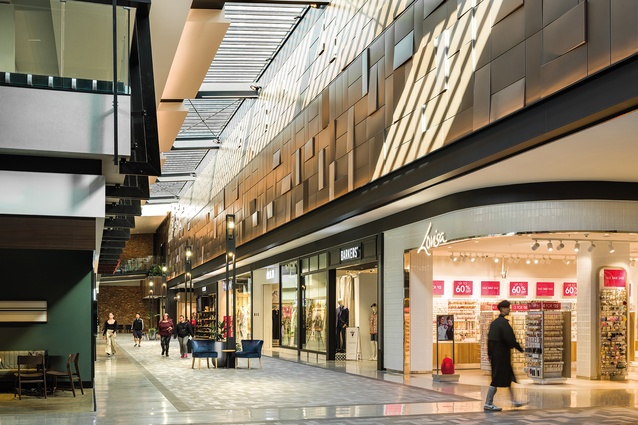Invercargill renaissance
Megan Rule explores the layers of history and heritage behind the ambitious redevelopment of Invercargill Central by Buchan.
The opening of the Invercargill Central commercial retail centre has catalysed opportunities for the city to consolidate and strengthen its central heart, and to embrace cultural interest in its progressive identity.
While the opening coincides with the recent closure of the H&J Smith department store founded in 1900, a number of significant building projects have emerged within a stone’s throw of the newly minted Invercargill Central.
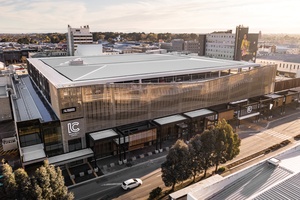
The new ILT hotel, The Langlands, by Warren and Mahoney features a swanky bar for city viewing from its top floor. The nearby Menzies Building (1966), an international-style former government office block opposite the railway station, is being retrofitted into a further premium hotel. The former central H&H bus depot houses an interim Public Art Gallery, while a remote new museum storage facility has just been completed to maintain Southland’s extensive archive collections. And the design competition for a new Museum Gallery to replace the distinctive L F Simpson pyramid (1990) envelope addition over E H Smith’s Southland Museum and Gallery (1942)1 was won by an out-of-town team of architects in 2023. The pyramid was perhaps as controversial at the time as was I M Pei’s Paris Louvre Pyramid (1989) intervention.
From 1856, Invercargill was established to serve a future rich farming area, named after the then superintendent of Otago, Captain William Cargill, with ‘Inver’ referring to ‘the meeting of two waters’: the Ōreti and Makarewa Rivers. Surveyor John Turnbull Thomson settled on a location by the Ōreti River estuary, near the Otepuni Creek tributary, the site of today’s redeveloped Invercargill Central block.2 The site block is defined by a prominent southwest roundabout intersection with Tay and Dee Streets, bisecting the main thoroughfares to Bluff from Dunedin and from Queenstown, also known as the Bank Corner, with the Troopers’ Memorial for Boer War servicemen (1908) by R N Vanes.
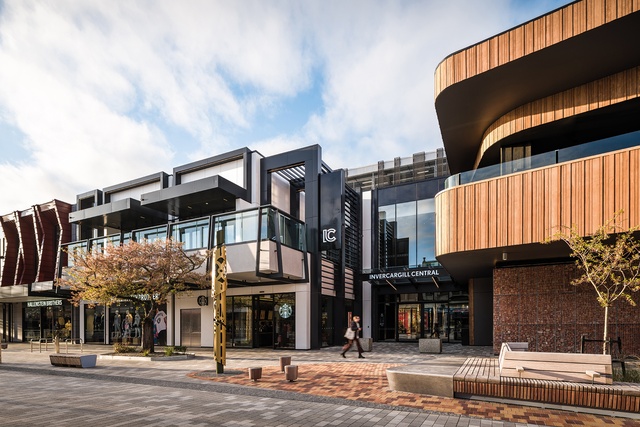
HWCP Management was formed as a public-private partnership between HW Richardson Group (HWR) and Invercargill City Council, to revitalise, purposefully, this pivotal Invercargill central-city block. The stakeholders selected Buchan to design the project, because of its expertise in the delivery of similar commercial and retail precincts, and an established relationship.
Invercargill’s climate is not for the faint-hearted, with an Antarctic chill that can come over the province during any season. These changeable conditions are often front of mind in a region dominated by the primary production sector. That said, it enjoys some beautiful weather, scenery and cultural heritage.
A fully covered car park was a priority, for its obvious benefits during inclement weather. This enabled a reduced cost to the structure and has achieved more than 650 parking spaces, accessed from Tay Street, in a multi-level car park above the retail space. A new office building, mezzanine office spaces, existing cinema complex and a future medical centre within the block are all served by the car park, already popular and nearing capacity.
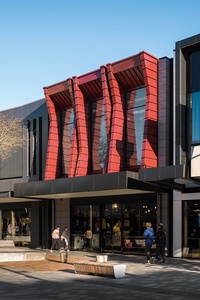
The city has a history of covered pedestrian-prioritised retail, with A C Ford’s Cambridge Arcade (1934), an Art Deco remodel of the 1907 Victorian buildings within the Invercargill Central site, Barham & Barham’s Courtville Place (1959), a modern adaption and expansion of the former Princess Hotel in the neighbouring block, the Southern Institute of Technology or former Bank Arcade (1987) and South City Mall (1987).
Buchan’s architects were presented with a city block with street-level occupancy while many of the upper-level spaces had been empty, some for as long as 30 years.
Over several decades, the retail area of Invercargill had decentralised, with newer big-box retail chains and businesses building on the city periphery, where it was perhaps easier to acquire larger sites to suit their scale with associated parking. Consequentially, a number of the buildings were becoming less attractive for premium occupancy without solid investment.
An initial vision phase of the project began in 2014. At that stage, the feasibility was linked to bringing the various owners or properties in the city block under common ownership or collaboration, inevitably through acquisition.3
The conceptual design phase began in earnest in 2017, with overall planning of the block site. The project had a staged completion, with the anchor tenant, Farmers, opening in the first stage alongside several other retail outlets.
There were a number of hurdles to overcome, not least the retention of valued heritage buildings within the site, a successful urban interface with neighbouring blocks and an effective circulation hierarchy.
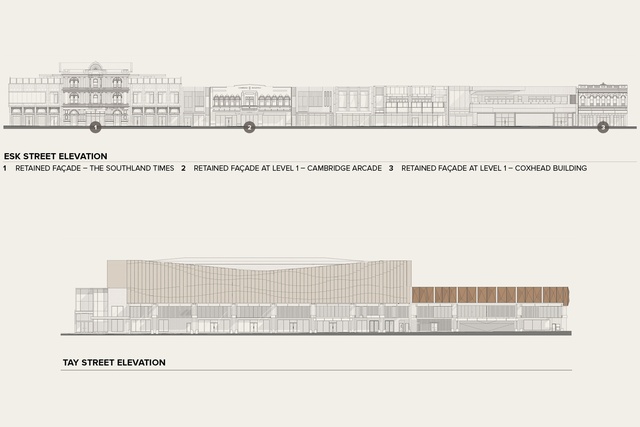
A complex resource consent required the heritage consultant team to provide an in-depth heritage record of the many important buildings that made up the block — some 37 listed buildings, of which eight were considered to be of national significance. A benefit of the consent conditions was to provide a transparent project process and opportunity for public dialogue. A series of walking tours gave the public a fuller understanding of the site’s story. The city also supported the filming of a documentary, The Last Tour, where the late local architect and historian Mick Hesselin hosts a tour of the block before redevelopment.
C J Brodricks’s heritage-listed former Bank of New South Wales and Chambers (1904) at 1 Dee Street provided a collaborative office for the project consultants, and a public information office for the duration of the project.
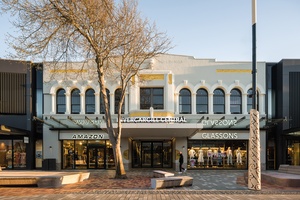
Invercargill Central’s north-facing Esk Street elevation has been redeveloped in a contemporary response, scaling new buildings at two- and three-storey heights, in keeping with several intermittent retained heritage façades. The city has also upgraded the Esk Street thoroughfare as a shared space with paving and urban street furniture. Exterior material themes are intentionally extended by the architects into the interior of the commercial and retail complex.
In a comprehensive conservation and heritage report, the most revered or redeemable existing building façades were identified, mainly in Esk Street, for saving. These included The Southland Times building (1909) by C H Roberts, the only building to maintain a full ground-up façade, the Art Deco remodel of Cambridge Arcade (1934) by A C Ford and Coxhead Building (1875) by F W Burrell with ornate Neoclassical façades.4
The project team worked together to repurpose materials and components from historic buildings that were not retained: ornate Victorian verandah steel columns, timbers on tables, bricks in slip walls, broken bricks in gabion walls, pressed-metal ceiling tiles in walls and solid timber doors in eatery service rooms. Even an historic town clock from the NZIC building (1884) has been incorporated into the new interior of the Market Lane pedestrian thoroughfare.
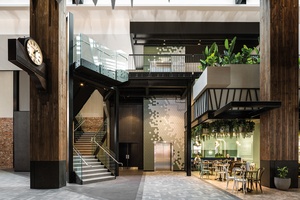
The overall city master plan for the block has the four corners occupied by taller and significant marker buildings standing out, with generally lower-level building and façade infill to the street perimeters. Notably, A G A Milne’s Kelvin Hotel (1965) remains as one of Invercargill’s leading-edge early international-style tall buildings of eight storeys.5
A new, functional streamlined office block of nine storeys commands the northern corner aspect of the block, replacing both the Lewis & Co building (1914) by E Anscomb & H McDowell Smith, an innovative Chicago revivalist-style building with early steel arch windows, and the corner Newburgh building (1929) by B Ager.6
The project sets out to appreciate the city’s prominent heritage, scale and weather, by bringing the outdoor streets indoors in much the same way as the Cambridge building’s modern arcade update did in the early 1930s. The interior street experience is heightened by tall, generous public spaces and glazed skylights abutting a decorative, textured metal cladding to the parking building exterior above.
The overall site is divided into complementary precincts, with the anchor department retail relating to The Southland Times building while an eating zone orientates to the sun, with a direct link through to the existing Reading Cinemas (1992) group.
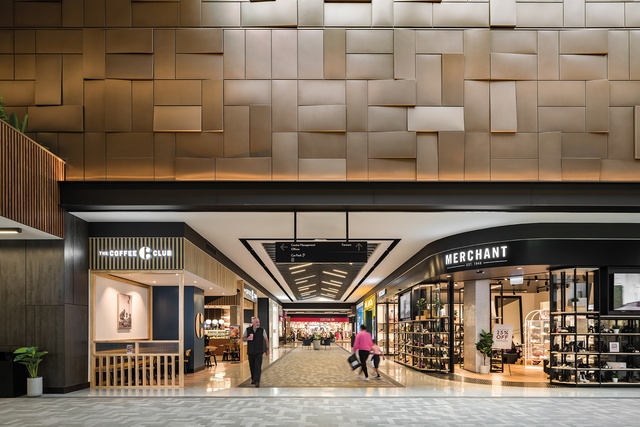
First-level mezzanine offices with north-facing balconies overlook the revitalised Esk Street shared space. Sectional layers of Southern Alp shapes formed in knitted Kaynemaile polycarbonate mesh are suspended from the ceiling: high in a continuous line above the Market Lane.
The historic Cambridge Arcade Art Deco façade and entry is retained as a new mall entry, although this once-strong axis that connected a pedestrian crossing on Tay Street is usurped by a new tenancy facing onto Tay Street.
Esk Street’s newer buildings between the historic façades maintain complementary scales, materials and textures with contemporary entries.
In contrast, the Tay Street frontage is given over to the multi-level car park, finished with the versatile Kaynemaile mesh screen. The screen presents an engaging monolithic, woven seismic-like texture and is illuminated at night-time with lively changing patterns.
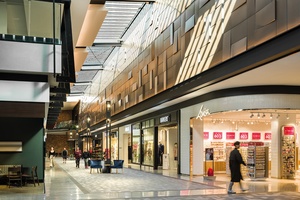
A challenge for the city and the architects is to represent the harder-edged Tay Street frontage in all weather as a desirable activity location with appealing visual- and people-friendly thresholds into the new development and across the wider, multi-lane street. The relocation of the city bus services to this strip of the street appears to have encouraged increased activity along this main arterial route, together with the vital continuous deep verandahs providing public shelter. In this case, the architects have sought to overscale the verandahs, with double-height, shipping-container-like steel frames portraying a more industrial language, and an associated ground-level, three-lane-wide single entrance to the car park.
Post-construction additions to this verandah of mini bus shelters and chunky concrete blocks (to deter ram raids) suggest an important pedestrian-friendly challenge may still remain with further thoughtful design of this important urban space. With several city-block gaps on this Tay Street stretch still to be constructed within the larger project, there remains an opportunity for the community to see improved scale and legibility on the main street with a similar level of attention to that apparent in the Esk Street precinct.
Despite a less navigable and inviting public interface to the main Tay Street address, the reinvigorated interior hub and Esk Street frontage engagement brings a welcomed new energy and spotlight to Invercargill’s city centre.
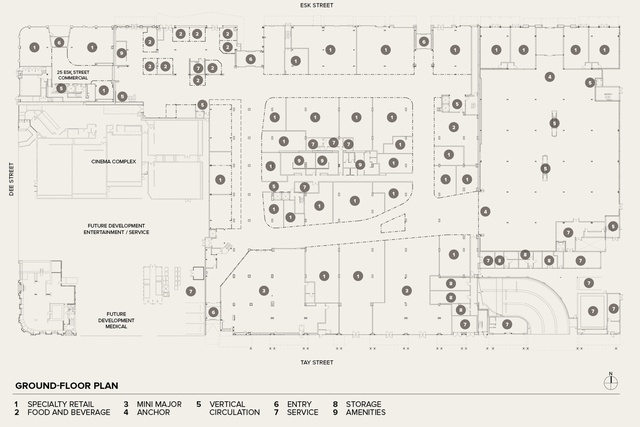
References
1. Norman Ledgerwood, Southern Architects: A History of the Southern Branch, New Zealand Institute of Architects. Dunedin: Southern Branch, New Zealand Institute of Architects, 2009, p. 141.
2. Paul Sorrell (ed.), Murihiku: The Southland Story. Invercargill: Dan Davin Literary Foundation, 2006, p. 66.
3. Logan Savory, The Southland Times, 13 July 2022.
4. Naomi Woods and Dawn Cropper: NZ Heritage Properties Ltd consultants, Invercargill Central Redevelopment: A Heritage Impact and Archaeological Assessment of Block II, Town of Invercargill. Dunedin, September 2018, p.8. https://icc.govt.nz/wp-content/uploads/2018/10/HWCP-Appendix-C-HIA-Part-1.pdf Andrea Farminer and Robin Miller: Origin Consultants, Invercargill City: Central City Area: Heritage Buildings Re-Assessment 2016. Dunedin, November 2016. https://icc.govt.nz/wp-content/uploads/2016/12/Heritage-Building-Report-2016.pdf
5. Ledgerwood, Southern Architects, 2009, p. 140.
6. Woods and Cropper, Invercargill Central Redevelopment, 2018, p. 18.


